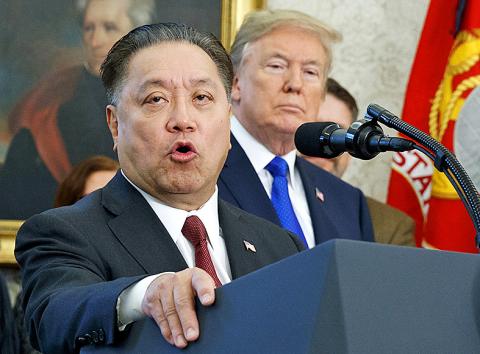US President Donald Trump on Monday blocked an unsolicited bid by Singapore-based Broadcom to take over smartphone chipmaker Qualcomm, citing national security concerns.
Trump issued an order barring the proposed mega-acquisition, saying there is credible evidence such a deal “threatens to impair the national security of the United States,” a White House statement said.
The order came despite Broadcom’s assurances that it would complete its move to the US by early next month, ahead of a previously planned Qualcomm shareholder vote on the US$117 billion deal — meaning any national security concerns were moot.

Photo: AP
“Broadcom strongly disagrees that its proposed acquisition of Qualcomm raises any national security concerns,” it said, adding that it was reviewing the order.
The US Department of the Treasury said in a letter over the weekend that Broadcom had violated a Committee on Foreign Investment in the US (CFIUS) order on three separate occasions by failing to give advance notice before taking actions, such as lodging takeover-related securities filings in the US.
A CFIUS investigation of the proposed acquisition so far has “confirmed” national security concerns earlier identified by US officials, according to the letter.
Trump ordered Broadcom and Qualcomm to “immediately and permanently abandon the proposed takeover.”
The rival chip giants were told to notify CFIUS in writing that all aspects of the order had been followed.
Qualcomm has been maneuvering for weeks to rebuff Broadcom’s unwanted advances and had asked CFIUS to look into national security implications of a merger.
Concern over China’s potential influence and rising US protectionist sentiment hung over the Singaporean firm’s hostile takeover bid.
Qualcomm rejected multiple Broadcom offers during weeks of parries and thrusts between the two firms since the proposed deal emerged in November.
CFIUS said that a Broadcom-Qualcomm merger could weaken Qualcomm’s leadership in the field. This would likely help Chinese competitors, such as telecommunications firm Huawei Technologies Co (華為), particularly in the emerging 5G wireless Internet, where a stronger China could present a national security issue.

LONG FLIGHT: The jets would be flown by US pilots, with Taiwanese copilots in the two-seat F-16D variant to help familiarize them with the aircraft, the source said The US is expected to fly 10 Lockheed Martin F-16C/D Block 70/72 jets to Taiwan over the coming months to fulfill a long-awaited order of 66 aircraft, a defense official said yesterday. Word that the first batch of the jets would be delivered soon was welcome news to Taiwan, which has become concerned about delays in the delivery of US arms amid rising military tensions with China. Speaking on condition of anonymity, the official said the initial tranche of the nation’s F-16s are rolling off assembly lines in the US and would be flown under their own power to Taiwan by way

OBJECTS AT SEA: Satellites with synthetic-aperture radar could aid in the detection of small Chinese boats attempting to illegally enter Taiwan, the space agency head said Taiwan aims to send the nation’s first low Earth orbit (LEO) satellite into space in 2027, while the first Formosat-8 and Formosat-9 spacecraft are to be launched in October and 2028 respectively, the National Science and Technology Council said yesterday. The council laid out its space development plan in a report reviewed by members of the legislature’s Education and Culture Committee. Six LEO satellites would be produced in the initial phase, with the first one, the B5G-1A, scheduled to be launched in 2027, the council said in the report. Regarding the second satellite, the B5G-1B, the government plans to work with private contractors

‘NARWHAL’: The indigenous submarine completed its harbor acceptance test recently and is now under heavy guard as it undergoes tests in open waters, a source said The Hai Kun (海鯤), the nation’s first indigenous defense submarine, yesterday began sea trials, sailing out of the Port of Kaohsiung, a military source said. Also known as the “Narwhal,” the vessel departed from CSBC Corp, Taiwan’s (台灣國際造船) shipyard at about 8am, where it had been docked. More than 10 technicians and military personnel were on deck, with several others standing atop the sail. After recently completing its harbor acceptance test, the vessel has started a series of sea-based trials, including tests of its propulsion and navigational systems, while partially surfaced, the source said. The Hai Kun underwent tests in the port from

MISSION: The Indo-Pacific region is ‘the priority theater,’ where the task of deterrence extends across the entire region, including Taiwan, the US Pacific Fleet commander said The US Navy’s “mission of deterrence” in the Indo-Pacific theater applies to Taiwan, Pacific Fleet Commander Admiral Stephen Koehler told the South China Sea Conference on Tuesday. The conference, organized by the Center for Strategic and International Studies (CSIS), is an international platform for senior officials and experts from countries with security interests in the region. “The Pacific Fleet’s mission is to deter aggression across the Western Pacific, together with our allies and partners, and to prevail in combat if necessary, Koehler said in the event’s keynote speech. “That mission of deterrence applies regionwide — including the South China Sea and Taiwan,” he